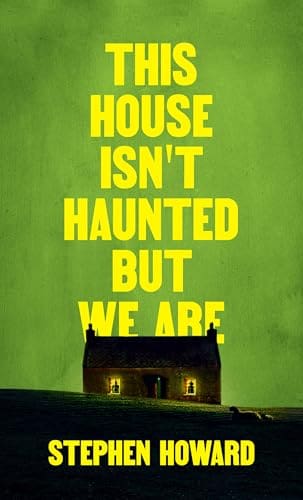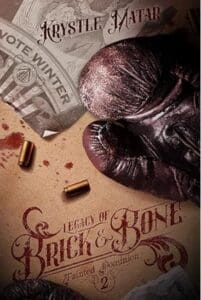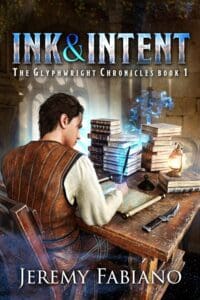
Synopsis:
Simon and Priya’s young daughter has died in a tragic accident. Determined to heal their fracturing marriage, the couple move to the North Yorkshire Moors to renovate a dilapidated rural cottage. However, they just can’t process their grief as increasingly eerie events unfold. A child’s ghostly figure appears on the moors, doors lock themselves, and a mysterious stain grows from the loft. Is it their daughter haunting them or something else?
Review:
“This House Isn’t Haunted But We Are,” is a haunted house novel that reeks of sour grief and manure… proper Northern, like. Just like Howard, I’m holed up somewhere in Cheshire (please don’t track me down unless it’s to hand me books) so perhaps I’m biased- but the North of England is fertile ground for horror… and is all too often overlooked. I really couldn’t tell you why. We’re practically leaking folklore… I encourage all readers to google Yorkshire’s Lake Semerwater, Northumbria’s “Raggle Taggle Gypsy,” or Manchester’s “Black Shuck.” We’re full of crooked characters and bloody histories. Most importantly, besides the big cities, (which are their own kind of hellholes) if you’re in the North you’re probably in the middle of nowhere, and horror reader, to horror reader, the middle of nowhere is never good. If you still don’t believe me I ask you to turn your gaze to Wild Hunt Books’ “The Northern Weird Project,” which, as I’ve said before, as a weird northerner, I feel was created for me. Stephen Howard’s “This House Isn’t Haunted But We Are,” is the first instalment, and what an opening shot it is! A heart-breaking meditation on grief that truly refurbs the haunted house sub-genre, you’d be a fool to miss this slice of horror from up North.
We follow Simon and Priya, who were once loving parents to Lily. Following her death, the two have drifted apart, and moving to the Yorkshire countryside, into Simon’s Aunt Susan’s charming rental property, may just be the glue their marriage needs. It is, as houses in horror novels so often are, a fixer-upper. It has good bones…and loose roof tiles and dated furniture… and a menacing looking patch of mould in the corner. Aside from that, it seems standard. Surrounded by moorlands, one storey, a little damp, a little drafty, and haunted as fuck.
I’ve referenced Stephen Graham Jones’ new introduction to Robert Marasco’s “Burnt Offerings,” before, but it’s just so good, and it’s a free country, so I’m going to reiterate. Jones asserts that there are two essential types of haunted house, the one that wants you gone and will drive you out by any means necessary… and then the hungry haunted house, which wants you to stay forever. The house in “This House Isn’t Haunted But We Are,” if I were forced to categorise, is a hungry haunted house, but not an ill-intentioned one. It is, on balance, a lonely haunted house, who really is quite fond of its new inhabitants.
There’s a quiet sadness to the “haunting,” here that sets Howard’s novel apart from many others in the sub-genre. Rather than being a site of pure malevolence, the house becomes almost its own tragic character. In a narrative move as strange yet genius as Catriona Ward’s “The Last House on Needless Street,” we read not just from the perspective of the house… but from the second person perspective of the house. This strange metalepsis, and undeniably quirky narrative reframing allows us to see the haunted house not simply as architecture, but as a desperate, eager-to-please, borderline-neurotic empty vessel. It enhances the lovely, aching, emotional texture of the story and elevates what would perhaps otherwise be your run of the mill haunted house horror into something brilliant.
You and I are arguably living through a grief horror golden age with John Langan amongst others leading the charge. That being said, grief and horror have always gone hand in hand. Howard writes with real bleakness, raw heart and such naked emotional intensity that the characters of Simon and Priya, who are very much at different stages in their grief cycles, and thus at each other’s throats, almost jump off of the page. It’s the most crucial aspect of the novel. “This House Isn’t Haunted But We Are,” is not just an excellent title, but the thesis of the entire story, that courses through every fibre of every page.
In 106 pages Stephen Howard demonstrates that home is indeed where the heart is, and that it truly is weird up north. Tender, terrifying, and shot through with a real honesty that may just get you, I gobbled this up in a single sitting. “This House Isn’t Haunted But We Are,” is not just well-paced, well-executed and let’s be real, well-scary, but an exceptional salvo to what is bound to be an excellent set of books. If Howard’s opening is any indication, Wild Hunt are about to put Northern horror firmly on the map.









Leave a Reply